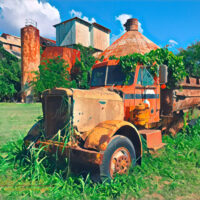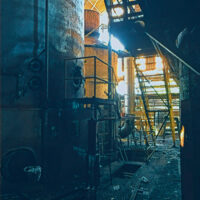The impact of the sugar industry in these islands simply cannot be overstated. For over a century sugar was the dominant industry in the islands consuming land, water, and people. These islands were shaped by sugar, physically and culturally.
So much of what you see today is a direct resut of sugar, many people and cultures that now call these islands home are descended from the immigrant laborers who came to work the plantations. These immigrants brought with them thier languages and so much more. So many traditions, foods, and words, blended with the Native Hawaiian culture to create the island culture we enjoy.
While this legacy is seen on almost all of the islands it seems most visible on the southern shore of Kauai, perhaps as these plantations were some of the last to shut down, and very little has replaced or re-developed in the area. Plantation towns sit in the shadow of rusting mills that loom over the landscape.
Surfing the satellite photos one can see the old field systems and cane haul roads that divide the landscape into complex geometric pattern. You can still trace the old rail lines that served the mills by their smooth curves and gentle grades. The mills sit in the center of these patterns like spiders in a web, all roads leading to the massive buildings that turned sugarcane into granulated money.
It is hard to escape the cultural effects of sugar. Eat a classic plate lunch at one of the many small diners scattered through the islands? This meal is a direct result of the meals a plantation worker would have eaten. A scoop of rice, a main portion of teriaki pork or chicken katsu? To this day a popular everyday fare. The same goes for the islands love of poke bowls and li hing mui shave ice.
The landscapes modified by the plantations remain today. Modern highways follow old railways and cross bridges built to serve the sugar mills. Dozens of old plantation towns now serve modern residents and tourists, are the centers of housing developments and resorts. The old sugar landings where steamers loaded sugar are now beach parks or small boat harbors that serve local ahi fishermen and dive boats.
The state’s current political landscape has been shaped by the rise to power of the plantation workers and their descendants. While most Native Hawaiians followed Prince Kuhio into the Republican party and dominated local politics during the last half of the nineteenth and first half of the twentieth century, after WWII power shifted to the labor unions and the Democratic party that emerged from the sugar plantations. The party now dominates state politics almost exclusively.
For better or worse, tourism has replaced sugar as the dominant industry. The old sugarcane fields now grow coffee, papaya, or ATV tours. So many of the disagreements that divide these islands are a direct result of the sugar era. Arguments over diversions of water, land, and political power echo in community meeting halls and legislative chambers.
Sugar may be gone, but it still remains in the fabric of the islands.





Great article
Aloha